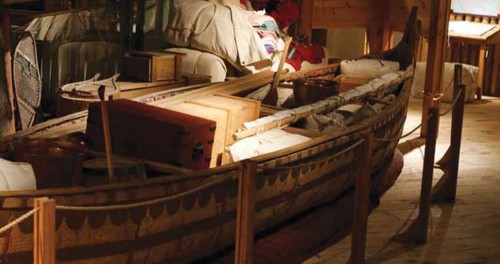The Canadian Canoe Museum
A hands-on interactive experience
 Voyageur canoe
Voyageur canoe
Paddling on a beautiful, still lake is a peaceful experience. The sun starts to rise in the distance and all around you are the echoing sounds of calling loons as your paddle breaks the surface of the water. What can add to this wonderful experience is knowing you had taken part in building this vessel and carving the paddle being used to make the journey happen.
Kayaking and canoeing are ancient modes of transportation, surpassing all others except travelling by foot. In fact the canoe and kayak have a long and interesting history and are of major significance to Canadians. The Canadian Canoe Museum is a unique national heritage site that has an exceptional collection of canoes, kayaks and paddled watercraft. It’s a family-friendly museum with more than 100 canoes and kayaks on display. The museum also offers interactive, hands-on galleries, a scavenger hunt, model canoe-building and a puppet theatre for children. Through inclusive, memorable and engaging exhibits and programs we can share the art, culture, heritage and spirit of paddled watercraft in our communities.
Located in Peterborough, the museum’s holdings number more than 600 canoes, kayaks and paddled watercraft. The collection includes pieces the origins of which span the country from coast to coast and represent many of the major watercraft traditions of Canada.
The museum’s artifacts range from the great dugouts of the First Nations of the Pacific Northwest to the singular bark canoes of the Beothuk of Newfoundland, from the skin-on-frame kayaks of northern peoples from Baffin Island in the east to the Mackenzie River Delta in the northwest to the all-wood and canvas-covered craft manufactured by companies with names like Herald, Peterborough, Chestnut, Lakefield and Canadian. Over the years, paddled watercraft from as far away as Paraguay and the Amazon have helped the museum expand its reach and scope to include international examples.

Students at workshops
There are many workshops offered by the museum for the general public as well as educational programs for students. The programs are directly linked to most courses in the Ontario curriculum through the unique lens of the canoe and its cultures. Rooted in the principles of experiential education, participants learn through song, story, roleplay, adventure, carving, making, baking and imagining. Interactive, hands-on, inquiry-based learning with a cross-curricular First Nations emphasis is also accessible for students with special needs and different learning styles.
The programs include Treaty Canoe, an introduction to the historical treaty process based on the Williams Treaties, the first of which was signed in 1923. Students carry out a simulated treaty negotiation, playing the roles of First Nations and government agents. (Grade 10: Canadian History since World War I; Aboriginal Peoples in Canada; Grade 11: Current Aboriginal Issues in Canada; Grade 12: Aboriginal Governance: Emerging Directions.)
In Kayak Discovery, students working in small groups are given an introduction to the idea of kayak-building as a community task in traditional Inuit cultures where different members play distinct and crucial roles. (Grade 9-12: Visual Arts; Grade 9: Native Studies; Grade 9-12: Canadian and World Studies; Grade 9-12: Business Studies; Grade 12: Health and Physical Education.)
Full-Size Paddle Carving involves a one-day paddle-carving program for youth ages 15-18. Soapstone Carving is a hands-on experience carving soapstone in the context of the Arctic Galleries and Inuit artifacts. Loon Carving uses a 4 x 6 inch block of soapstone to create a silky smooth sculpture in the iconic loon shape. (Grade 9-12: Arts; Grade 9-12: Visual Arts; Grade 9: Native Studies; Grade 10: Civics and Citizenship.) Watercolour Painting offers an exploration of painting techniques. (Grade 9-12: Visual Arts.)
Voyageur Canoe provides a four-hour tour of the beautiful and historic Otonabee River, followed by soapstone carving. Students have the unique experience of paddling a 26-foot north canoe or canot du nord that is a replica of the canoes used in Canada’s fur trade. Students also learn about voyageur history and First Nations’ roles in the fur trade.
In Canoe Literature, students learn about the centrality of the canoe to Canadian cultures and how they clearly portrayed in numerous works of art and literature. Students see Canada through the eyes of explorers, prospectors, First Nations peoples, fur traders and even modern-day recreational canoeists. (Grade 9-12: English.)
Finally, Sleepover at the Museum is an adventurous evening of learning that features any two programs from the list above.
The museum also offers a wide variety of adult workshops and new classes are added every year. Whether you’re interested in woodworking, weaving, leatherwork, sewing or simply learning a new skill, there is something for everyone to enjoy.
Visit www.canoemuseum.ca to find the hours of operation and details on the workshops. For more information on how the educational programs connect to the secondary curriculum, e-mail education@canoemuseum.ca or call 705.748.9153 extension 203.

Leave a comment